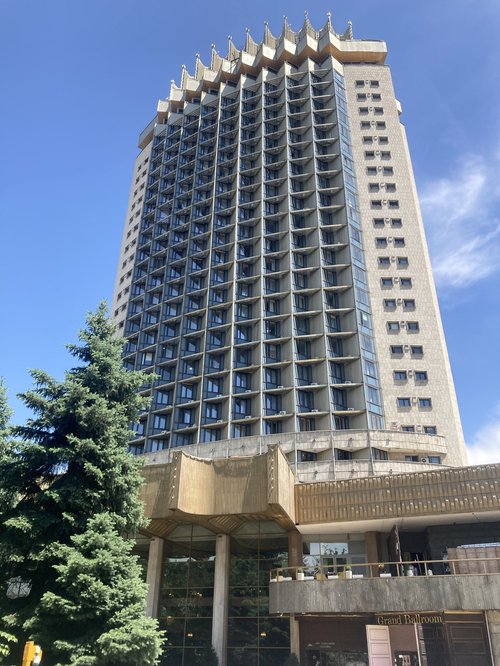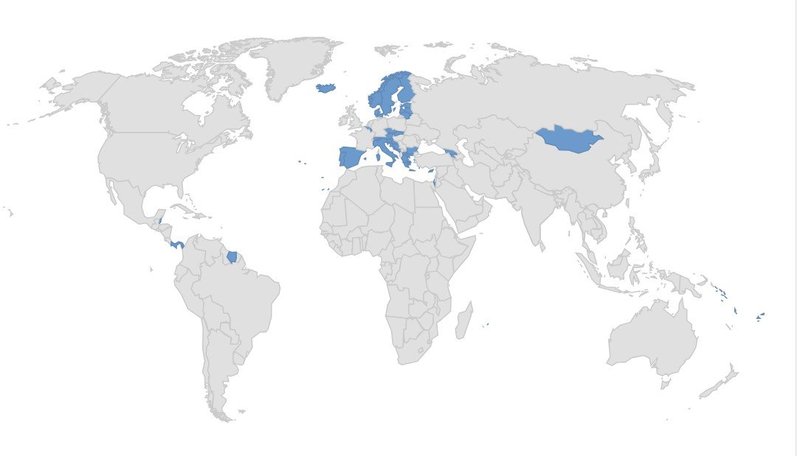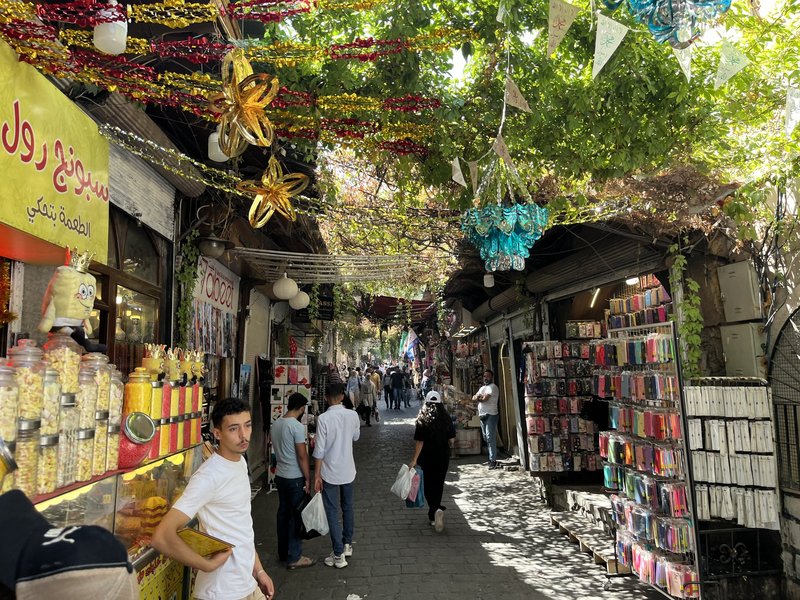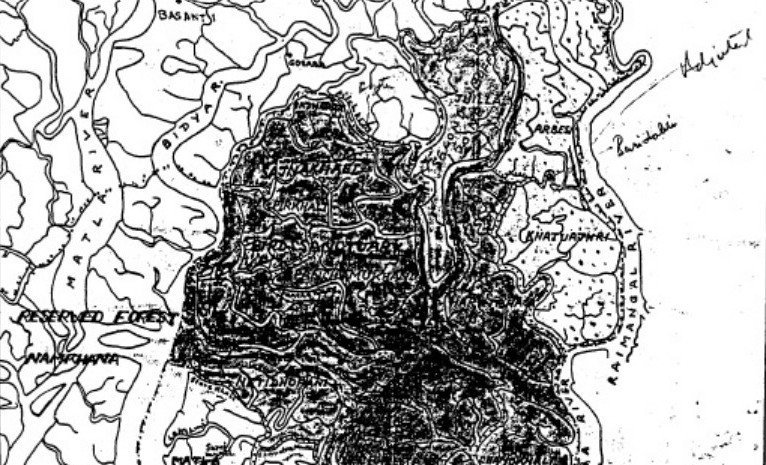Revised Tentative List for Kazakhstan
Country – November 17, 2025 by Els Slots
Look back at your past trip notes and photos to see if you have something covered from Kazakhstan's revised Tentative List.
New are:
- Architectural Resilience: The Anti-seismic Heritage of Almaty
- Medeu – Complex of Mudflow Protection Engineering Structures
- Monumental Monuments and Sanctuaries of the Early Steppe Tradition of Central Eurasia (Mausoleum of Kozy-Korpesh–Bayan Sulu, Ritual Structure Dombauyl, and related "Dyng" Towers)
The Almaty site includes three well-known structures in the city: the Ascension (Voznesensky) Cathedral (1904–1907), the House of Government of the Kazakh SSR (1950s–1957) and the Kazakhstan Hotel (1977).
Merged into one are:
- Petroglyphs of the Karatau Range (Arpaozen and Sauyskandyk)
- Petroglyphs of Zhetysu (Kulzhabasy, Eshkiolmes, and Bayan-Zhurek)
Four of these were previously listed as single TWHS. They had no coverage (reviews or visitors) on this website.
Bay of Islands
Country – November 15, 2025 by Els SlotsNew Zealand is currently working on a new Tentative List; candidate sites can be submitted until January 2026. So its current Tentative List has to be taken with a pinch of salt. Still, I find it likely that there will be a candidate to represent the Bay of Islands (located at the northeast end of the North Island). This area holds the current TWHS of Kerikeri Basin and the TWHS of the Waitangi Treaty Grounds. Additionally, the Bay Island town of Russell has also publicly advertised its candidacy. So they might show up, either individually or as a serial site or a cultural landscape. They all relate to the same part of New Zealand history: the first decades of coexistence between the British and the Maori in the first half of the 19th century.
I visited these three sites on one day, basing myself in the town of Kerikeri.
Kerikeri Basin
Already on the drive up there from Auckland, I found that this region feels like the English countryside: green rolling hills, narrow winding roads, some livestock, and rain is never far away. Both the Maori and the British found the region’s fertile grounds and easy access by boat …
The Other Emirates
Country – November 2, 2025 by Els SlotsIn addition to the 3 major Emirates, the UAE comprises 4 other Emirates with a less strong international profile. Ajman, Fujairah, Ras Al Khaimah and Umm Al Quwain lie at the northern part of the peninsula, just below Oman's Musandam Governorate. They did not get priority on the road to WH nominations. Abu Dhabi had to be first, of course, Dubai had to be second, but failed with Khor Dubai, and Sharjah succeeded with the Faya Palaeolandscape this year. But all other Emirates, except for tiny Ajman, now have sites on the UAE Tentative List. Together with fellow community members Philipp and Jay, I visited nine of them on a two-day road trip in and out of Sharjah City.
The original design of my itinerary, as posted here on the Forum, did not work out in reality. After calculating the driving times, the full loop would be too much to do in one day, so we spread it out across two days while also incorporating the Faya Paleolandscape WHS. Also, to do it Emirate by Emirate made no sense, as their boundaries are all over the place. Below is a day-by-day, chronological account.
Day 1: Center and …
Core Zone Maps Update
Website – October 25, 2025 by Els SlotsIt was less than 2 months ago that I wrote about the first set of findings from adding core zones to our maps. Within 3 months of having started our mapping project, we’re now past halfway, and we have gone beyond UNESCO's estimation of “48% that have no adequate map“.
Progress
So far, 649 different WHS have been given a Core Zone map and 43 countries are covered in full. To my knowledge, this is already by far the best coverage anywhere on the web; the UNESCO World Heritage Centre added "site boundary polygons" to 289 WHS on the official website, according to its latest report (July 2025).
Community members who submit are considerably more skilled than I expected (or have more stamina than I do), and there are also fewer poor maps than I had been led to believe by UNESCO reports. A core zone border hand-drawn on a physical map may look unprofessional, but that does not mean it is bad per se: as long as the outline follows recognizable elements, you can make sense of it.
The mapped WHS were mostly (547, 84%) drawn by community members. Thank you so much _oscar, mmarquez, JayT …
Countries with too many WHS…
Country – October 18, 2025 by Els SlotsI came across an interesting statistic (thanks, Ian, for sharing) about the countries that have more than 1 WHS per 1 million inhabitants.
These are:
Andorra - Antigua and Barbuda – Armenia – Austria - Bahrein - Barbados - Belgium - Belize - Bosnia Herzegovina - Bulgaria - Cabo Verde – Croatia - Cyprus - Czechia – Denmark - Dominica – Estonia – Fiji - Finland - Georgia – Greece – Iceland - Israel - Italy – Kiribati - Latvia - Lithuania - Luxembourg - Malta - Marshall Islands - Mauritius - Micronesia - Mongolia - Montenegro - North Macedonia - Norway - Palau - Panama – Portugal - Saint Kitts and Nevis - Saint Lucia - San Marino – Seychelles - Slovakia - Slovenia - Solomon Islands - Spain – Suriname - Sweden - Switzerland – Vanuatu - Vatican City
(Considering “every country deserves at least 1 WHS”, the ones with more than 1 are bolded.)
Plotted on a map, the overachievers appear as follows. 32 of these 52 countries are in Europe!

A WHS for every million?
If we continue with the hypothesis that a country is allowed 1 WHS for every 1 million …
Dolphins in the spotlight
Connection – October 11, 2025 by Els SlotsEarlier this week, I started to update our Whales connection, but quickly discovered that we don’t have one for Dolphins yet (except for the very specific River Dolphins). I don’t think there’s a reason to have a connection for Whales and not for Dolphins: they are about as common, and while the Whales may be more impressive, the Dolphins often are more fun!
The new connection can be found here. Please find below some findings while compiling it.
What’s the difference between Whales and Dolphins?
They are very closely related: scientifically speaking, a dolphin is a type of toothed whale. However, in common language, "whale" typically refers to the larger cetaceans, especially the baleen whales, while "dolphin" refers to the smaller, typically more agile members of the toothed whale group.
For the connection, I will include all of the Family Delphinidae: Oceanic dolphins. This also includes the Killer Whale, or Orca, the largest species of dolphin. Similarly, Pilot Whales and False Killer Whales are also dolphins.
What’s the best WHS to see Dolphins?
In terms of the number of named species, the Marquesas Islands and the Lagoons of New Caledonia stand out with 11 and 10 different …
Travel-Related Nightmares on Repeat
Travel – October 4, 2025 by Els SlotsI don’t think I am a very anxious traveller and I daydream about the sunny side of travel a lot. But a couple of times a year, I wake up in the middle of the night from a nightmare, where I am trapped in a travel-related loop that gets worse and worse….
The Chad Visa
I am in line for a visa to Chad. Well, that’s to say the queue with the people all getting their visas is to my right. I am standing on the left side of the desk. For some reason, I am trying to pick up this visa in Germany, not at an embassy, but at a counter that resembles a post office. All the other people are receiving their visas, but there’s something wrong with mine. They have the application with my name on it, but I need to make another appointment. But I only have 3 weeks left! I try to plead, go through other options (Brussels!) in my head… and then wake up.
I visited Chad years ago, so I no longer need a visa for Chad. Also, for my upcoming trips, I have no difficult visa procedures. Could it be because I …
Meetup in the UAE Nov 1-2
Travel – October 1, 2025 by Els SlotsFor those in the Gulf region in early November, there's an option to join me on a short (T)WHS-focused trip.
The plan is:
Saturday, November 1, 2025: visit to Faya Paleolandscape WHS (both the Mleiha entrance and the Buhais Geology Park entrance), Mleiha TWHS (some later remains across the street) and Hatta Hill TWHS (shortlisted).
Sunday, November 2, 2025: road trip along the Tentative Sites of the UAE in the north of the peninsula, taking in all Emirates except for Abu Dhabi and Dubai.
You can join for 1 or 2 days, bring your own car or ride with me. All options are open. I will be starting from Sharjah City.
More details can be found here. Send me a message if you want to join.
Top Tips for travelling to Syria
Country – September 20, 2025 by Els SlotsI made at least two earlier, failed attempts to visit Syria. I rediscovered a Bradt Syria guidebook from 2006 in my bookcase, so I probably tried around 2008-2009, but the trips got cancelled. But as I now can see the end of my “country wish list”, Syria was at the very top. As a destination, it also has the advantages that it does not require a long international flight from Western Europe and that its “Cost per WHS” is low.
So here are some tips for travelling to Syria at the moment (September 2025), with the caveat that the situation on the ground can change at any time for better or worse in this highly flammable region.

It’s open for business
It is hard to find the “best” time to visit Syria, but now it is easier than it has been for years. It still is slightly earlier on my 'Windows of Opportunity' curve (as described here) than I usually do, but it definitely is past the “sights have yet to reopen” stage. All WHS and all major Points of Interest were easily accessible, no need for permits, except for Palmyra and the Aleppo Citadel. There are many checkpoints …
Core Zone Findings
Website – August 30, 2025 by Els SlotsSome three months ago, I announced to the other members of the WH Map Data Working Group: “I found my new summer hobby!”. And I was right: I love learning a new skill and there is a meditative quality to nailing down a core zone in a specific way so it can be shown on our maps.
Here are my main findings after having added core zone maps to some 200 WHS. You can follow the current standings and future progress at the dedicated Forum Topic.

We cannot do all, but we can get far quickly
It seems a gigantic task, but progress has been good. On average, it takes me about 20 minutes to make one. And yes, of course, I am picking the low-hanging fruit first, but most natural WHS (often national parks displayed correctly on any map already) or the more recent cultural ones are easy to do. Cultural landscapes are a drama as they are a WH-specific “fiction”.
We can also import them from other sources: community members who did some mapping in the past, or “professional” resources such as Protected Planet (cooperating with IUCN for the natural WHS but not always correct), or the …